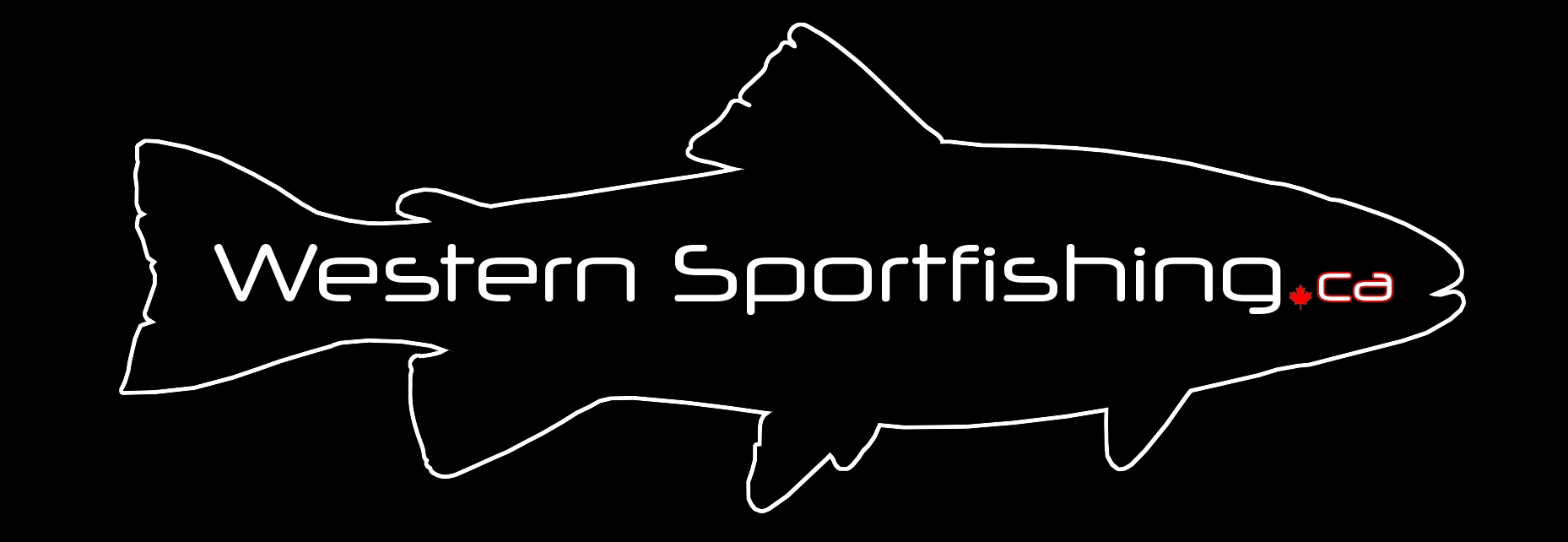
Early Season Stillwater Secrets
Barring any early season forays to the Crow, Stauffer or the Bow,
the first trip of the year for me is usually a lake. This is
because I can usually have better fishing in the early season while
hunting stillwater rainbows than I can by flogging water that is too
often
 clouded
by field run off. I like to follow a few simple strategies
that help me in my search, and these tips aren’t the overly
technical ones you might think if you’ve been reading those books
from Washington, Montana of even BC. No, these are tips that
target greedy trout. Trout that would attack stockers if they
get put in at around 4”es, trout that attack 4 inch leeches and
trout that eat stickleback by the school. And the best part is
in the right lakes these trout are often the biggest of the year.
clouded
by field run off. I like to follow a few simple strategies
that help me in my search, and these tips aren’t the overly
technical ones you might think if you’ve been reading those books
from Washington, Montana of even BC. No, these are tips that
target greedy trout. Trout that would attack stockers if they
get put in at around 4”es, trout that attack 4 inch leeches and
trout that eat stickleback by the school. And the best part is
in the right lakes these trout are often the biggest of the year.
Find open water. As dumb and obvious as this sounds you can
have good fishing as soon as there is enough water to lay down a
cast. We’ve caught some nice fish as soon as there is 30 or 40
feet of ice off, and using a TNT and leech could be the order of the
day. Cast your flies and an indicator as close to the ice as
you can and do a slow hand twist retrieve towards shore. Start
with your flies about 3-4 feet from the surface of the water and
lower them about a foot with each 3 or 4 casts until you get into
some fish. While you might like to fish leeches or nymphs with
a sinking line, the indicator is essential to allow the slowest
possible retrieve.
I’m not going to talk about water features to look for because at
this stage you’re basically just casting into
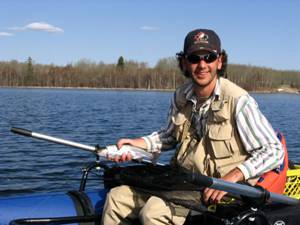 whatever water is open, and if fish are there, great. If not…
well, it’ll be another few days before the ice comes off and you can
take your boat out and explore.
whatever water is open, and if fish are there, great. If not…
well, it’ll be another few days before the ice comes off and you can
take your boat out and explore.
Once the ice is completely off the lake you should have 3 days to a
week of superb fishing before turnover kicks in and buggers
everything up. Unlike the ice off stage a boat is more or less
required for your success to be as good as possible. The fish
tend to be clumped together during this period, so you might have to
cover some water to catch fish. Water shallower than 8 or so
feet is usually what I look for, but my largest rainbow came at an
astounding 1.5 feet. Because some searching is involved, a
sinking line and a leech is a great tactic. You can troll
around the good-looking parts of a lake, but I like to mix casting
and trolling. Always be sure to try both techniques in an area
before you give up.
While the water depth is key, the underwater structure is probably
just as important. Shoals are what you should be looking for,
and again, 8 feet or less is probably what you should be looking
for. Don’t overlook the really shallow sections by shore
either. That mucky, “8 feet of loon crap” type bottom can
harbor a lot of insects and because it is dark it often heats up
sooner, and remains a degree or two above the rest of the water in
the area. It might seem insignificant, but this one or two
degree difference can attract some amazing fish.
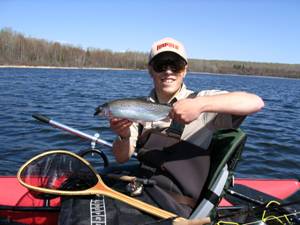 During
turnover the fishing is really hit or miss. The best thing you
can do is to cover a lot of water and use dark flies. Dark
flies make a better silhouette than light flies, and fish are more
likely to be able to see them. Again, shoals are probably your
best bet but the trout can be found deeper, and last spring the best
depth we found during turnover was around 15 feet deep.
During
turnover the fishing is really hit or miss. The best thing you
can do is to cover a lot of water and use dark flies. Dark
flies make a better silhouette than light flies, and fish are more
likely to be able to see them. Again, shoals are probably your
best bet but the trout can be found deeper, and last spring the best
depth we found during turnover was around 15 feet deep.
I can’t emphasize the importance of a
fish finder or
depth sounder
in lake fishing. I don’t use it for finding fish, but rather
to know what line I should be using, or what depth to set my
indicator. If you know how to read the screen, it will also
show you bottom contours as well as composite.
So, now that turnover is complete it’s time for the regular spring
hatches to get under way, and chironomids lead the way. I’m
not going to talk about how to fish them, but rather refer you to
Confessions of
a Chironomid Addict. Once other hatches such as
dragonflies, damsels and mayflies start hatching, the regular spring
fishing season has begun.
When fishing in the spring there are some things you can do to help
insure success. Carrying a variety of fly
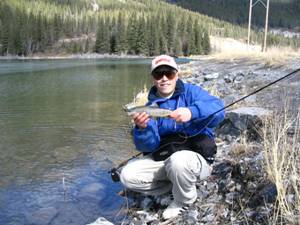 lines is important. I would rank them in order of importance
as follows: floating, intermediate sink (clear), type 3, and type 4.
The floating line should be strung with about a 12-14 foot leader
for any possible chironomiding and the sinking lines should be
attached to 4-7 feet of 6-8 pound test tippet material.
lines is important. I would rank them in order of importance
as follows: floating, intermediate sink (clear), type 3, and type 4.
The floating line should be strung with about a 12-14 foot leader
for any possible chironomiding and the sinking lines should be
attached to 4-7 feet of 6-8 pound test tippet material.
One thing that is rarely talked about when early season trout
fishing is talked about is clothing. Wow. Wearing the
right cloths can make a huge difference, especially when it’s colder
than sin out there. Wear some good long johns- preferably
wicking long johns-,
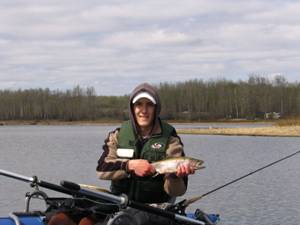 fleece
pants and either neoprene or lightweight/breathable waders.
The same layering strategy should be done on the upper half of your
body, but you’ll probably want to carry an extra top and also a
rain/windproof jacket. I like a breathable rain jacket because
that way I don’t need to switch coats or take it off if the rain
lets up and it gets hotter than Hell’s kitchen. I’ll usually
take a pair of wool gloves and even a toque, depending on the
weather forecast.
fleece
pants and either neoprene or lightweight/breathable waders.
The same layering strategy should be done on the upper half of your
body, but you’ll probably want to carry an extra top and also a
rain/windproof jacket. I like a breathable rain jacket because
that way I don’t need to switch coats or take it off if the rain
lets up and it gets hotter than Hell’s kitchen. I’ll usually
take a pair of wool gloves and even a toque, depending on the
weather forecast.
Well, that’s about all the tips I use when hunting down early season trout. I guess taking a fishing buddy or two helps out. On one side its nice to have another line in the water to help locate fishing or find a good pattern. Another good reason is that it’s a hell of a lot more fun to fish and get skunked with someone else. At least that’s one person who’ll believe your story.
Written by: Nick Sliwkanich